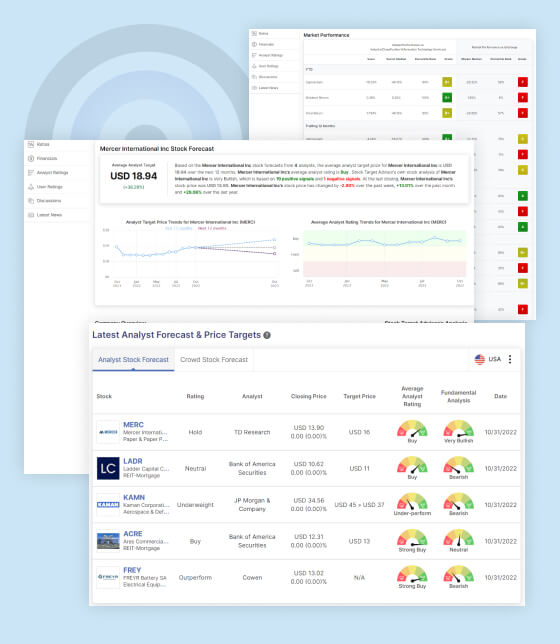Latest Analyst Stock Ratings and Price Targets
Search for analyst stock ratings and price targets by country, date, analyst, action and rating.0
Analyst Ratings
added today
6,746
Analyst Ratings added
in Last 30 days
Show ratings and price targets of :
Stock ratings and stock price targets from top stock analyst firms
Loading...
Frequently Asked Questions
The decision to buy depends on many factors such as an investors risk tolerance, investmetn thesis and structure of investment portfolio. However, based on our analysis the following stocks have the highest potential : NOW,BKNG and CMG. You can get more information on Analyst Ratings
Analyst stock ratings are opinions of professional analysts about the investment potential of a particular stock. Analysts typically issue ratings on a scale of 1 to 5, with 1 being the strongest recommendation and 5 being the weakest. A typical 5-tier stock rating system uses : buy, overweight, hold, underweight and sell ratings.
Analysts consider a variety of factors when assigning stock ratings, including the company's financial performance, industry outlook, and management team. They may also use technical analysis to assess the stock's price chart and identify potential trends.
The most common types of analyst stock ratings are:
- Buy: The analyst believes that the stock is undervalued and has the potential to outperform the market.
- Hold: The analyst believes that the stock is fairly valued and is likely to perform in line with the market.
- Sell: The analyst believes that the stock is overvalued and is likely to underperform the market.
Investors should use analyst stock ratings as one tool among many when making investment decisions. It's important to do your own research and consider your own investment goals and risk tolerance before making any investment decisions.
An analyst stock target is an estimate of the price at which an analyst believes a stock will be fairly valued within a certain time period, typically 12 months. Analysts use a variety of factors to set stock targets, including the company's financial performance, industry outlook, and management team.
Analysts use a variety of valuation methods to set stock targets. Some of the most common methods include:
- Discounted cash flow (DCF) analysis: DCF analysis is a method of valuing a company by discounting its future cash flows to the present value.
- Comparable company analysis: Comparable company analysis is a method of valuing a company by comparing it to similar companies that have already been acquired or have gone public.
- Relative valuation: Relative valuation is a method of valuing a company by comparing its valuation to other companies in the same industry or sector.
Some of the factors that analysts consider when setting stock targets include:
- The company's financial performance: Analysts look at the company's revenue, earnings, and cash flow to assess its financial health and growth potential.
- Industry outlook: Analysts consider the overall outlook for the company's industry, including factors such as economic growth, competitive landscape, and regulatory environment.
- Management team: Analysts assess the experience and track record of the company's management team.
- Technical analysis: Analysts may also use technical analysis to assess the stock's price chart and identify potential trends.
Investors should use analyst stock targets as one tool among many when making investment decisions. It's important to do your own research and consider your own investment goals and risk tolerance before making any investment decisions.
Here are some tips for using analyst stock targets effectively:
Here are some tips for using analyst stock targets effectively:
- Look at the consensus target: The consensus target is the average target of all analysts who cover the stock. This can be a good starting point for understanding what analysts think about a particular stock.
- Consider the analyst's track record: Not all analysts are created equal. Some analysts have a better track record than others. It's important to look at the analyst's track record before giving too much weight to their target. Stock Target Advisor makes this very easy by grading each analyst based on their historic accuracy by sector.
- Understand the factors behind the target: When an analyst sets a target, they should provide a rationale for their decision. This rationale will help you to understand the analyst's thinking and to assess the validity of their target.
- Don't rely on analyst targets alone: Analyst targets are just one tool that investors can use to make investment decisions. It's important to do your own research and consider your own investment goals and risk tolerance before making any investment decisions. Stock Target Advisor makes research easy for you by auatomatically analyzing stocks based on 100s of factors everyday and presenting the informaiton in a simple, transparent and easy to understand manner.
Analyst stock ratings and price targets are not always accurate. In fact, studies have shown that analysts tend to be overoptimistic on average. However, analyst ratings can still be a useful tool for investors, especially when used in conjunction with other investment analysis tools. StockTargetAdvisor helps you make informed investing decisions with the help of Analyst ratings in two ways:
- We measure historic accuracy of each analyst for a particular sector and grade them on it. This way you can only focus on analysts who have been historically more accurate about stocks in a particular sector.
- We combine analyst stock ratings and targets with automatic and unbiased fundamental analysis using our cutting edge algorithms so you can evaluate stocks objectively.
Loading...



